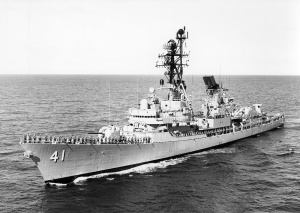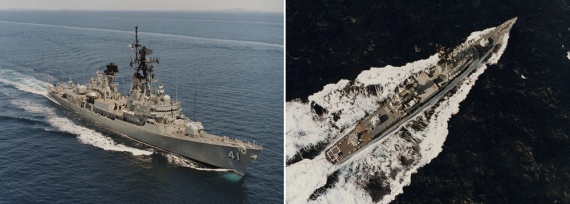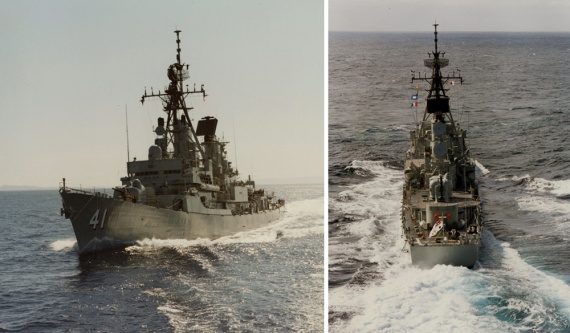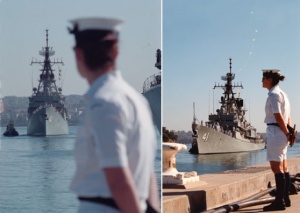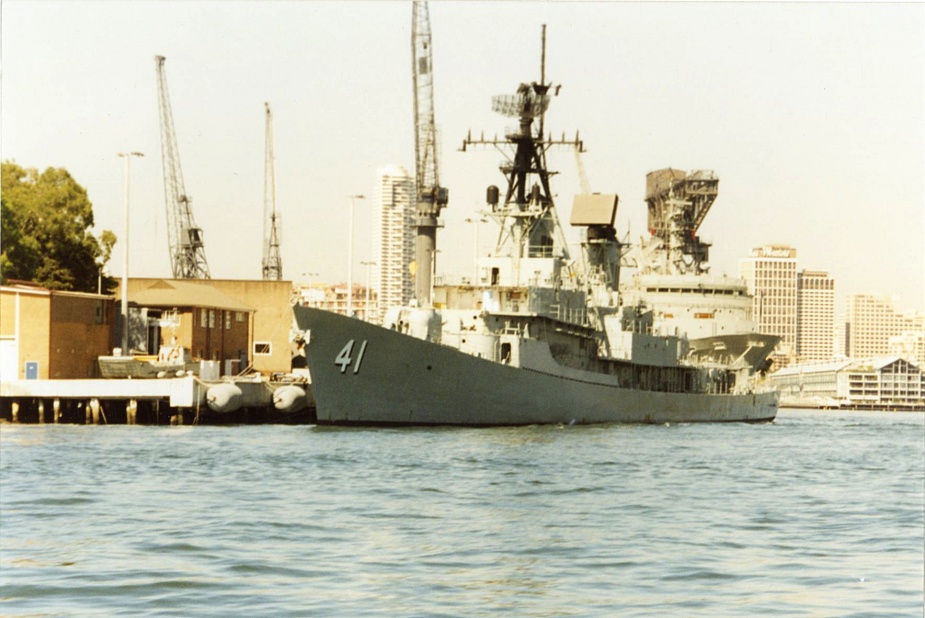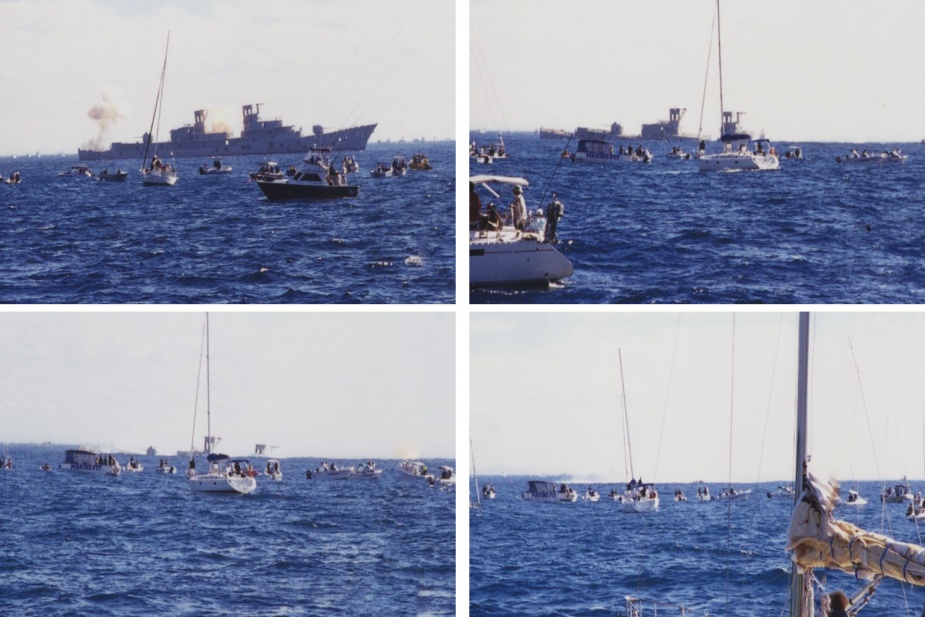HMAS Brisbane (II) - Part 2
| Class |
Charles F Adams (Modified Perth) Class |
|---|---|
| Type |
Guided Missile Destroyer |
| Pennant |
D41 |
| Builder |
Defoe Shipbuilding, Bay City Michigan, USA |
| Laid Down |
15 February 1965 |
| Launched |
5 May 1966 |
| Launched by |
Mrs FC Chaney, Wife of Minister for the Navy |
| Commissioned |
16 December 1967 |
| Decommissioned |
19 October 2001 |
| Dimensions & Displacement | |
| Displacement | 4850 tonnes |
| Length | 133.2 metres |
| Beam | 14.3 metres |
| Draught | 6.1 metres |
| Performance | |
| Speed | 36 knots |
| Complement | |
| Crew | 311 |
| Propulsion | |
| Machinery | Two General Electric geared steam turbines driving two shafts |
| Horsepower | 70,000 |
| Armament | |
| Missiles | SM-1 surface-to-air missiles |
| Guns | 2 x 5-inch 54 calibre rapid fire guns |
| Torpedoes | 2 x Mk 32 triple torpedo tubes |
| Awards | |
| Inherited Battle Honours | INDIAN OCEAN 1917 |
| Battle Honours | |
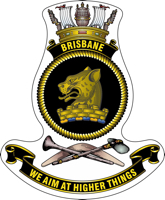
The advent of the 1990s saw Brisbane return to sea on 31 January 1990 to participate in a Fleet Concentration Period in New Zealand waters in February. She returned to Sydney on 22 February and commenced preparations to deploy to Hawaii for RIMPAC 90. Brisbane departed Sydney on 26 March in company with HMA Ships Adelaide (II), Darwin and Success (II).
Embarked in Brisbane was a stationary bike which was to 'race' the ship to Hawaii. The bike was ridden 24 hours a day with 50 members taking 45 minute shifts. The ship's Physical Training Instructor, Leading Seaman Danny Healy, came up with the idea to raise money for Tufnell House while motivating the ship's company to stay physically fit. Healy himself rode the first leg. Upon the ship's arrival at Pearl Harbor on 8 April, the charity bike ride had completed 330 hours and 8948kms, raising some $3000 for the charity.
RIMPAC exercises began on 16 April and continued throughout the month until 8 May. Brisbane remained in the Hawaiian exercise area after RIMPAC, later setting a course for home on 31 May. She arrived back in Sydney, via Pago Pago and Noumea, on 21 June and participated in Exercise PITCH BLACK off the Northern Territory in July. Brisbane again visited her namesake city at the beginning of August where members of her crew formed a working bee at Tufnell House, presenting the home with a cheque for $3000 and a new television, the proceeds of which were from the Hawaiian charity bike ride.
Brisbane arrived back home in Sydney on 6 August where an unscheduled upgrade began to better prepare the destroyer for a potential operational deployment to the Arabian Gulf.
On 10 August 1990 the then Prime Minister RJ Hawke affirmed Australia's commitment to send RAN warships to the Persian Gulf as part of a Multinational Naval Force assembling to enforce sanctions on Iraq following its invasion of neighbouring Kuwait. Under the Australian codename Operation DAMASK, HMA Ships Adelaide (II), Darwin and Success (II) were the first to sail, with Brisbane and Sydney (IV) tipped to follow later.
A number of Brisbane's on board systems were upgraded. Besides satellite communications equipment and electro-optical surveillance systems, these improvements included; new electronic warfare equipment; better chaff decoy rounds; radar absorbent material (RAM) panels to reduce the ship's radar cross section; and extra firefighting and damage control equipment. To improve efficiency of boarding operations the old sea boats were replaced with two new rigid hull inflatable boats (RHIBs) which were to prove their worth during subsequent boarding operations in the Gulf. The most prominent structural change was the installation by dockyard workers of a pair of Phalanx Close-in-Weapons Systems (CIWS) for greater protection against missile attack.
On 15 October Brisbane, in company with Sydney, sailed for a tailored two week pre-deployment workup before both ships departed for the Middle East on 12 November under the auspices of Operation DAMASK II. A number of VIPs farewelled the ship's company including Prime Minister Bob Hawke, AC, MP, and the Premier of New South Wales, Nick Greiner, MLA.
On 30 November, just before entering the Middle East Area of Operations (MEAO), the ships were advised that the United Nations Security Council had adopted Resolution 678 authorising the use of force against Iraq unless it withdrew from Kuwait by 15 January 1991. On 3 December, Prime Minister Hawke announced that Australian units were allowed to pass through the Strait of Hormuz and enter the Arabian Gulf. Brisbane and Sydney were to form part of the largest grouping of warships seen since the end of World War II. The multi-national coalition included some 90 warships, more than 100 logistic, amphibious and smaller craft, and 800 aircraft from 15 nations.
Brisbane was host ship for two visiting PLA-N ships Yichang and Taichang in early October, and she conducted a Youth Sea Day with 64 guests embarked on 8 October. Her final sea time was spent exercising in company with HMAS Melbourne (III) the following day before anchoring in Jervis Bay overnight. She steamed up the NSW coast on 10 October before making her final entry into Sydney later that day.
HMAS Brisbane decommissioned on 19 October 2001 in front of approximately 1700 guests marking the end of the DDG era in the RAN. More than 7000 officers and sailors served in Brisbane during her service life. Brisbane now lies as a dive wreck 4.2 miles off Point Cartwright on the Queensland coast and forms the centrepiece of the 'Ex-HMAS Brisbane Conservation Park'.
One of Brisbane's 5-inch gun mounts may be found on display outside the Australian War Memorial in Canberra, positioned in front of her bridge and forward superstructure which forms part of the the post-1945 conflicts gallery.

